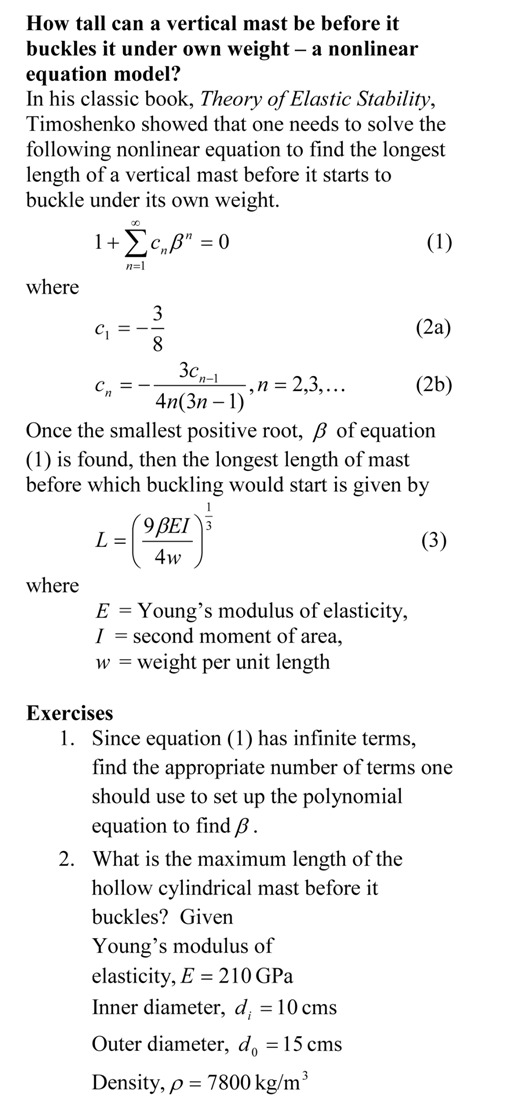In the previous post, http://autarkaw.wordpress.com/2010/06/10/a-real-life-example-of-having-to-solve-a-nonlinear-equation-numerically/, we set up the polynomial equation for the problem of finding the length of the mast before which it buckles under its own weight. In this blog, we show you how the polynomial equation is solved. Since the polynomial equation has infinite terms, we also show you how we choose how many terms of the polynomial need to be used.
It is better to download the program as single quotes in the pasted version do not translate properly when pasted into a mfile editor of MATLAB or you can read the html version for clarity and sample output .
%% FINDING THE SMALLEST POSITIVE ROOT OF A POLYNOMIAL EQUATION FOR A
% In a previous blog at autarkaw.wordpress.com (June 10), we set up a
% polynomial equation that would allow us to find the longest mast
% that can be setup before it buckles under its own weight.
% In this blog, we will find the root of this equation.
% The problem is given at
% http://nm.mathforcollege.com/blog/length_of_mast.pdf
% and we are solving Exercise 1 of the pdf file.
%% TOPIC
% Smallest positive root of a polynomial equations with infinite terms
%% SUMMARY
% Language : Matlab 2008a;
% Authors : Autar Kaw;
% Mfile available at
% http://nm.mathforcollege.com/blog/rootinfinite.m;
% Last Revised : July 4, 2010
% Abstract: This program shows you how to find the smallest positive
% real root of a polynomial equations with infinite terms
clc
clear all
%% INTRODUCTION
disp(‘ABSTRACT’)
disp(‘ This program shows you how to’)
disp(‘ find the smallest positive real root’)
disp(‘ of a polynomial equations with infinite terms’)
disp(‘ ‘)
disp(‘AUTHOR’)
disp(‘ Autar K Kaw of http://autarkaw.wordpress.com’)
disp(‘ ‘)
disp(‘MFILE SOURCE’)
disp(‘ http://nm.mathforcollege.com/blog/rootsinfinite.m’)
disp(‘ ‘)
disp(‘PROBLEM STATEMENT’)
disp(‘ http://nm.mathforcollege.com/blog/length_of_mast.pdf)
disp(‘ ‘)
disp(‘LAST REVISED’)
disp(‘ July 4, 2010’)
disp(‘ ‘)
%% INPUTS
% prespecified tolerance, eps
eps=0.000001;
% maximum number of terms of polynomial
nmax=100;
%% DISPLAYING INPUTS
disp(‘INPUTS’)
fprintf(‘ The max number of terms of the polynomial chosen, nmax= %g’,nmax)
fprintf(‘\n The prespecified tolerance, eps= %g’,eps)
disp(‘ ‘)
disp(‘ ‘)
%% CODE
for N=2:1:nmax
% The above looop is to see how many terms we should take of the
% infinite polynomial
aa(1)=-3.0/8.0;
% Setting up the polynomial via recursive relations
for i=2:1:N
aa(i)=-3*aa(i-1)/(4*i*(3*i-1));
end
% Since it is a polynomial of order N,
% there are N+1 coefficients
% To set up the polynomial for MATLAB
% N+1 th coefficient is the constant term
% N th coefficient is the term of order 1
% and so on till 1st coefficient is of order N
bb(N+1)=1;
for i=1:1:N
bb(N-i+1)=aa(i);
end
% Finding all the roots of the Nth order polynomial
abc=roots(bb);
% Finding the first real positive root so that it
% would be used as the starting minimum value available
for i=1:1:N
if isreal(abc(i))==true & abc(i)>0
minval=abc(i);
break;
end
end
% Finding the smallest positive real root
for i=1:1:N
if isreal(abc(i))==true & abc(i)>0
if (abc(i) < minval)
minval=abc(i);
end
end
end
% Checking if prespecified tolerance is met
if N>2
absea=abs((minval-previous)/minval)*100;
if absea<=eps
terms_needed=N;
break;
end
end
previous=minval;
end
%% DISPLAYING OUTPUTS
disp(‘OUTPUTS’)
fprintf(‘ The number of terms used in the polynomial is %g’,terms_needed)
fprintf(‘\n The smallest positive real root is %g’,minval)
disp(‘ ‘)
________________________________________________________
This post is brought to you by Holistic Numerical Methods: Numerical Methods for the STEM undergraduate at http://nm.mathforcollege.com, the textbook on Numerical Methods with Applications available from the lulu storefront, and the YouTube video lectures available at http://www.youtube.com/numericalmethodsguy.
Subscribe to the blog via a reader or email to stay updated with this blog. Let the information follow you.
